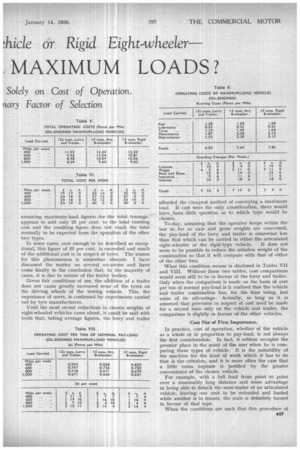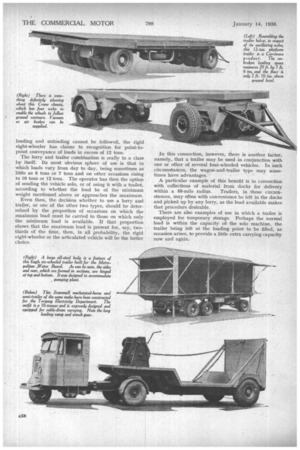Lorry and Trailer, Articulate !hide or Rigid Eight-wheeler
Page 14

Page 15

Page 16

If you've noticed an error in this article please click here to report it so we can fix it.
WHICH IS BEST Ft MAXIMUM LOADS?
Choice of Unit Does Not Convenience of Use i. Solely on Cost of Operation. rtary Factor of Selection COMPARISON of costs of operation of different types of vehicle is seldom safe. The manner of use, generally, differs, and it is that factor which is of the greatest importance in determining the ultimate cost of operation. Figures relating to individual experiences are of no help, because they are inevitably affected by the particular conditions of operation. Average fign,.res for cost are the most useful, but suffer from the disability mentioned.
A peculiar difficulty arises, moreover, in respect of the three types of vehicle which have reference •in the accompanying tables, namely, those designed to carry the maximum loads possible under Ministry of Transport regulations, in so far as normal traffic is concerned. The law insists that a maximum gross laden weight of 22 tons shall not, in ordinary circumstances, be exceeded. (A proposal contained in a draft amendment to the Construction and Use Regulations increases the gross weight allowance for steam wagons drawing trailers to 24 tons.) Three Types in General Use For all practical purposes, this restriction applies to vehicles having eight wheels. There are three types in common use which fall within that category, namely, the four-wheeled lorry drawing a four-wheeled trailer, the articulated vehicle, usually comprising a fourwheeled tractor and a semi-trailer resting on four wheels at the rear, and the rigid-type eight-wheeler.
The . accompanying figures are taken from The Commercial Motor Tables of Operating Cost, in compiling which certain principles have been laid down. One of these has always been that it is fair to include only figures directly incidental to the operation of the vehicle, excluding any items of expenditure that are not necessarily incurred. In the case of a lorry and trailer, the operator necessarily incurs expenditure under the item " wages of mate," because the law states that, in the operation of a lorry and trailer, a second mart must be employed.
There is no such provision in connection with the use _of an articulated vehicle or a rigid-type eight-wheeler. In the figures for the use of a trailer, therefore, " wages of mate" is included in The Commercial Motor Tables of Operating Cost, but not in the case of the other types. I am aware that many users of articulated and rigid eight-wheelers find it to their advantage to send a second man with the' driver, and I have always. insisted that, in making estimates for their own costs and using the Tables as a basis, they should Modify the figures accordingly.
The next point that arises in the, course of this comparison may be taken in respect onlY of the running costs. These show considerably to advantage as regards the lorry and trailer combination. Just .why that should be so is not easy to see. It is, -however, a fact that hitching a trailer on to the back of a lorry, and assuming maximum-load figures •for the total tonnage, appears to add only 25 per cent. to the total running cost and the resulting figure does not reach the total normally to be expected from the operation of the other two types.
In some cases, rare enough to be described as exceptional, this figure of 25 per cent. is exceeded and much of the additional cost is in respect of tyres. The reason for this phenomenon is somewhat obscure. I have discussed the matter on several occasions and have come finally to the conclusion that, in the majority of cases, it is due to misuse of the trailer brakes.
Given fair conditions of use, the aadition of a trailer does not cause greatly increased wear of the tyres on the driving wheels of the towing vehicle. This, the experience of users, is confirmed by experiments carried out by tyre manufacturers.
Until the most recent reductions in chassis weights of eight-wheeled vehicles came about, it could be said with truth that, taking average figures, the lorry and trailer afforded the cheapest method of conveying a maximum load. If cost were the only consideration, there would have been little question as to which type would be chosen.
To-day, assuming that the operator keeps within the law so far as axle and gross weights are concerned, the pay-load of the lorry and trailer is somewhat less than that which can be carried in either the articulated eight-wheeler or the rigid-type vehicle. It does not seem to be possible to reduce the unladen weight of the combination so that it will compare with that of either of the other two.
What this condition means is disclosed in Tables VII and VIII. Without those two tables, cost comparisons would seem still to be in favour of the lorry and trailer. Only when the comparison is made on the basis of cost per ton of normal pay-load is it realized that the vehicle and trailer combination has, for the time being, lost some of its advantage. Actually, so long as it is assumed that provision in respect of cost need be made for a second man only on the vehicle and trailer, the comparison is slightly in favour of.the other vehicles.
Cost Not of First Importance.
In practice, cost of operation, whether of the vehicle as a whole or in proportion to pay-load, is not always the first consideration. In fact, it seldom occupies the premier place in the mind of the user when he is comparing these types of vehicle. It is the suitability of the machine for the kind of work which it has to do that is the criterion, and it is more often the case that a little extra expense is justified by the greater convenience of the chosen vehicle.
For example, with a full load, from point to point over a reasonably long distance and some advantage in being able to detach the semi-trailer of an articulated vehicle, leaving one unit to be unloaded and loaded while another is in transit, the scale is definitely turned in favour of that type.
When the conditions are such that this procedure of 417 loading and unloading cannot be followed, the rigid eight-wheeler has claims to recognition for point-topoint conveyance of loads in excess of 12 tons.
The lorry and trailer combination is really in a class by itself. Its most obvious sphere of use is that in which loads vary from day to day, being sometimes as little as 6 tons or 7 tons and on other occasions rising to 10 tons or 12 tons. The operator has then the option of sending the vehicle solo, or of using it with a trailet, according to whether the load be of the minimum weight mentioned above or approaches the maximum.
Even then, the decision whether to use a lorry and trailer, or one of the other two types, should be determined by the proportion of occasions on which the maximum load must be carried to those on which only the minimum load is available. If that proportion shows that the maximum load is present for, say, twothirds of the time, then, in all probability, the rigid eight-wheeler or the articulated vehicle will be the better choice. In this connection, however, there is another factor, namely, that a trailer may be used in conjunction with one or other of several four-wheeled vehicles. In such circumstances, the wagon-and-trailer type may sometimes have advantages.
A particular example of this benefit is in connection with colleetions of material from docks for delivery
within a 50-mile radius. Trailers, in those circumstances, may often with convenience be left in the docks and picked up by any lorry, as the load available makes that procedure desirable.
There are also examples of use in which a trailer is employed for temporary storage. Perhaps the normal load is within the capacity of the solo machine, the trailer being left at the loading point to be filled, as occasion arises, to provide a little extra carrying capacity • now and again.


































